She sheds vary in size, functionality, and design, catering to diverse needs and preferences. Starter she sheds measure 130 square feet (12 square meters) to 160 square feet (15 square meters). Ceiling heights range from 7 feet (2.1 meters) to 8 feet (2.4 meters), and door widths from 3 feet (1 meter) to 4 feet (1.2 meters). She sheds serve multiple purposes, including personal sanctuaries, hobby rooms, home offices, fitness studios, and spaces for personal expression. Color schemes often include pastel blue, soft green, light pink, lavender, cream, sky blue, and warm yellow. Functional she sheds incorporate efficient design, adequate lighting, insulation, climate control, and ergonomic furnishings. Energy efficiency is achieved through natural ventilation, efficient heating and cooling systems, insulation, indoor air quality management, and ceiling fans. Small sheds (100 square feet or 9 square meters) may cost $2,000 to $4,000 (€1,850 to €3,700, £1,600 to £3,400). Factors affecting renovation include purpose, size, budget, weather conditions, material durability, aesthetics, and compliance with regulations. An architect is not required but can add value, especially in complex renovations. Architect fees range from $1,500 to $3,500 (€1,400 to €3,250, £1,200 to £2,800), depending on shed size and project scope. Depending on the project’s scale, redecorating a she shed can take 1 to 8 weeks. Homeowners face challenges in defining purpose, optimizing space, managing budgets, achieving a cohesive style, weatherproofing, accessing utilities, and adhering to regulations.
What is the typical size of a she shed?
A typical starter she shed ranges from 130 square feet (12 square meters) to 160 square feet (15 square meters). The interior width spans 10 feet (3 meters) to 12 feet (3.6 meters), while the length is 13 feet (4 meters) to 16 feet (5 meters). Ceiling heights are between 7 feet (2.1 meters) and 8 feet (2.4 meters), allowing enough overhead room. Single door opening widths range from 3 feet (1 meter) to 4 feet (1.2 meters). The average backyard she sheds for hobbies is 195 square feet (18 square meters) to 235 square feet (22 square meters). Widths allow space for a worktable and lounge chair, ranging from 12 feet (3.6 meters) to 14 feet (4.2 meters) across. Length averages 15 feet (4.5 meters) to 18 feet (5.5 meters). With a ceiling height between 8 feet (2.4 meters) and 9 feet (2.7 meters). The single door is 4 feet (1.2 meters) to 5 feet (1.5 meters) wide.
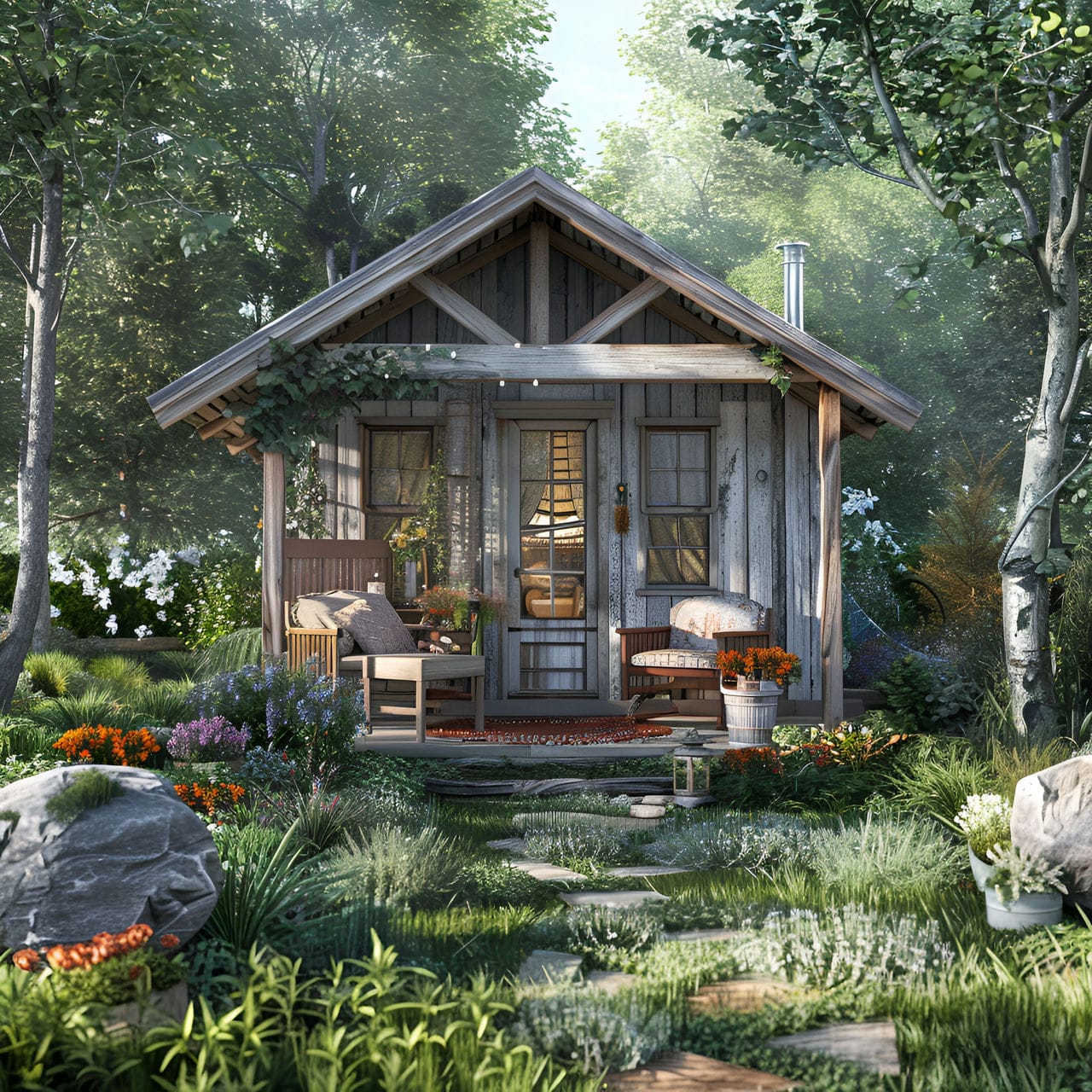
Deluxe custom sheds exceed 300 square feet (28 square meters) of space. Their increased width allows room for sinks, appliances, and ample workspace, spanning 14 feet (4.2 meters) to 16 feet (4.8 meters). Length ranges from 20 feet (6 meters) to 25 feet (7.5 meters). Having the headroom for tall storage, ceilings are at least 9 feet (2.7 meters), with many luxury sheds over 10 feet (3 meters) in height. The wide door opens from 5 feet (1.5 meters) to 6 feet (1.8 meters) across.
What is the use and purpose of a she shed?
A shed’s purpose is to provide a multifaceted catering to relaxation, hobbies, work, fitness, socializing, and gardening. Firstly, it acts as a personal sanctuary, offering a space away from the main household’s hustle and bustle. Women use she shed to unwind, relax, and engage in leisure activities, making them ideal for mental rejuvenation and stress relief. Secondly, a shed often functions as a hobby or craft room. It provides a dedicated space for activities like painting, sewing, gardening, or writing, away from the distractions of daily home life. Thirdly, she sheds are used as home offices. They offer a quiet and separate workspace, helping to maintain a healthy work-life balance. Fourthly, she sheds can serve as fitness or yoga studios. They provide a private space for exercise, meditation, or yoga, away from the confines and distractions of the main home. This private gym or studio setup benefits those who prefer a more personalized and secluded work environment. Lastly, she sheds are a means of personal expression. They allow women to design and decorate a space that reflects their style and preferences, which might only sometimes be possible in shared household spaces.
What is the typical shape of a she shed?
The typical shapes of a she shed are square or rectangular single-room. A shed floorplan is more comprehensive, ranging from 8 feet (2.5 meters) to 13 feet (4 meters) to allow workspace on one wall with an open floor space for supplies, materials, or displays. The depth spans 8 feet (2.5 meters) to 10 feet (3 meters). This layout positions lounge seating along the rear with the entry door on one end, maximizing wall space for shelving and windows. L-shapes and elongated rectangles operate well for sheds integrated within backyard structures or built off existing architecture.
What furniture commonly equips a she shed?
Listed below are the types of furniture commonly equip a she shed:
- Comfortable chairs: Comfortable chairs are essential furniture in a shed, designed to provide a cozy seating option. These chairs are often upholstered with soft fabrics and feature cushioned seats and backs for maximum comfort. The design varies from armchairs to lounge chairs, depending on the intended use, whether for reading, relaxing, or crafting.
- Worktables: Worktables are key furniture pieces in a shed, mainly if they are used for hobbies like crafting, sewing, or painting. These tables are sturdy and spacious, providing a large surface area for various activities. They are made of durable materials like wood or metal and may include features like drawers or shelves for storage.
- Storage units: Storage units are critical furniture in a shed, essential for organizing supplies and equipment. These units can range from shelving to cabinets or drawers, depending on the type of items stored. Made from materials like wood or metal, they are designed to maximize space usage and keep the shed clutter-free.
- Sofas or daybeds: Sofas or daybeds are popular furniture choices in a shed, providing a place for relaxation or casual seating. These pieces are smaller in scale to fit the limited space and can be upholstered in various fabrics to match the shed’s decor.
- Coffee tables: Coffee tables are functional furniture pieces in a shed, offering a convenient surface for drinks, books, or decorative items. These tables can be made from various materials, including wood, metal, or glass, and often feature a simple yet elegant design.
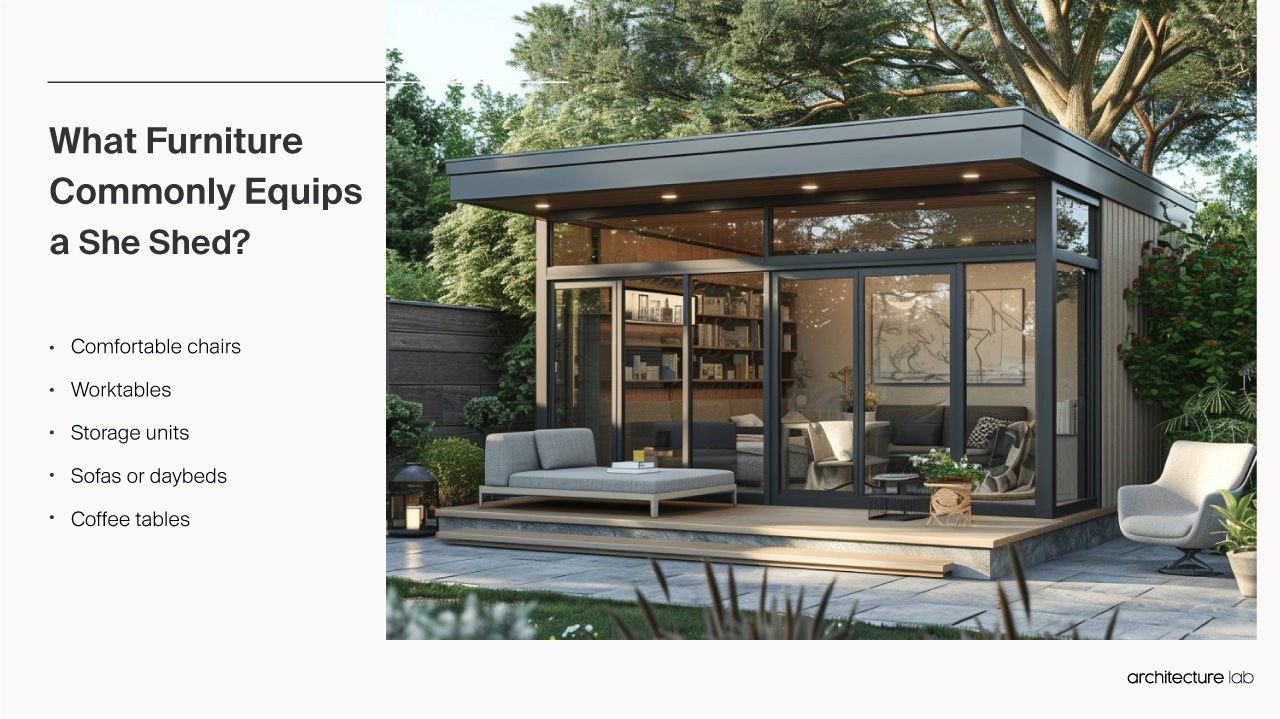
What is the normal ceiling height of a she shed?
The normal ceiling height of a she shed is 8 feet (2.4 meters). Average heights allow clearance for most lighting fixtures and ceiling fans without infringing on the required headroom. Contemporary she sheds may elevate architectural elements like beams or skylights starting at 27 square feet (2.5 square meters) up to 32 square feet (3 square meters). The smaller footprint she sheds, under 150 square feet (14 square meters), feels confined by ceilings exceeding 29 square feet (2.7 square meters). Some premier luxury sheds soar with ceiling treatments up to 43 square feet (4 square meters).
What colors are she sheds usually painted?
Listed below are the colors usually used in she sheds:
- Pastel Blue: She sheds feature pastel blue, a hue that promotes calm. This color suits spaces dedicated to relaxation or creative pursuits. Pastel blue enhances natural light when applied, making the room feel airy. Complementary decor includes white furnishings, light wood accents, soft throw pillows, and delicate window treatments.
- Soft Green: The pale green color is popular in the she sheds, symbolizing growth and harmony. This color is ideal for garden-inspired sheds or as a backdrop for indoor plants. Soft green walls create a refreshing environment, especially with natural materials like wood or bamboo.
- Light Pink: Light pink features in she sheds interiors convey gentleness. This color is perfect for crafting areas or cozy reading nooks. Decorative choices can include plush rugs, soft lighting, and feminine accents to create a comfortable space.
- Lavender Color: Lavender color is a frequent choice for she sheds, known for its soothing effects. Ideal for meditation or yoga spaces, lavender walls help create a peaceful retreat. Complementary colors include soft yellows or creams, adding warmth to the cool lavender.
- Cream: Cream color is a versatile and warm option for she sheds, offering a neutral yet inviting base. Cream walls act as a blank canvas, allowing personal styles and bold accents to stand out.
- Sky Blue: Sky blue is chosen for its refreshing and open feel in the sheds. Complementary colors like navy or teal add depth, while decor such as landscape paintings or sky-themed art pieces.
- Warm Yellow: Warm yellow is used in the sheds to create a lively and energetic environment. This color is for art studios or inspiring workspaces. Warm yellow walls brighten the space, pairing well with white or light gray for a balanced look.
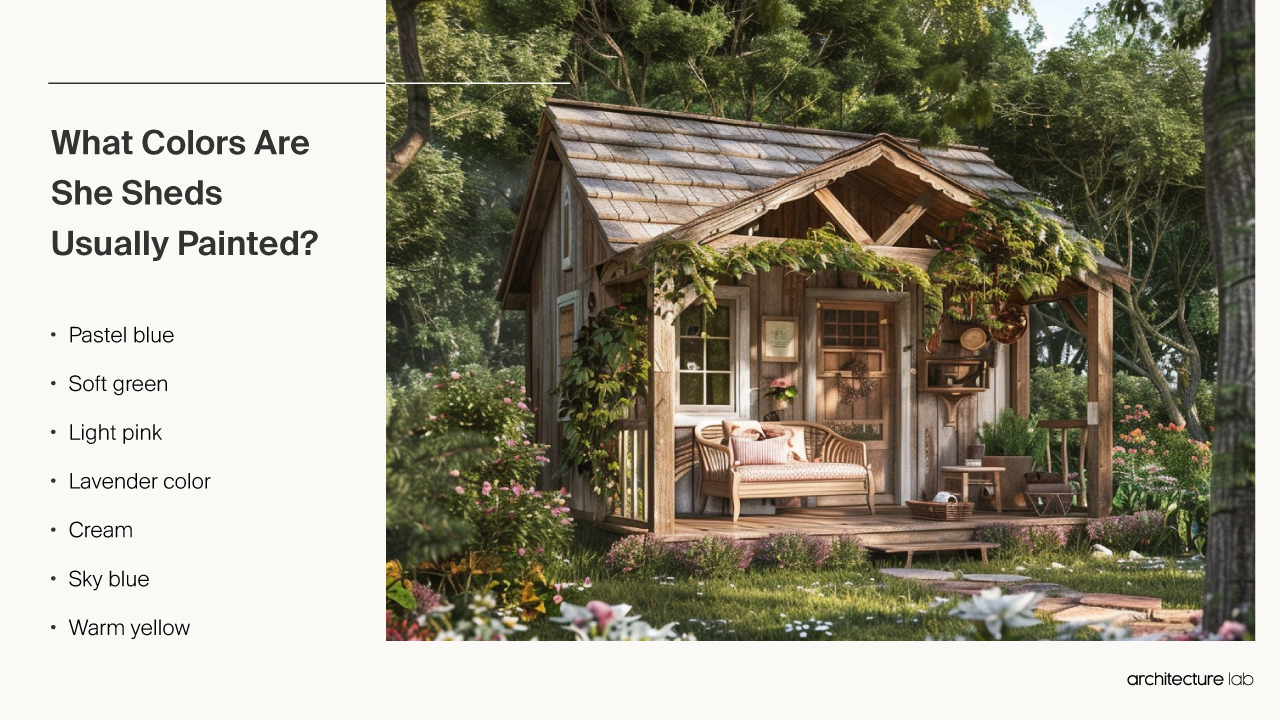
What makes the she shed functional?
The she shed is functional by efficient design and layout, effective lighting, adequate insulation and climate control, personalized customization, and furnishings. Firstly, its design and layout are crucial for maximizing space efficiency. A well-organized and thoughtfully designed layout ensures the shed is comfortable and versatile. Secondly, the inclusion of adequate lighting influences the functionality of a shed. Good lighting is necessary if the space is used for activities like reading, crafting, or working. Thirdly, proper insulation and climate control are vital for making a shed functional throughout the year. Effective insulation and heating and cooling options ensure the space remains comfortable regardless of weather conditions, making it a valid home extension. Lastly, comfortable and ergonomic furnishings contribute significantly to the shed’s function. Comfy chairs, practical worktables, and cozy decor make the space more inviting and ensure it can be used for extended periods without discomfort.
How is energy efficiency achieved in a she shed?
Energy efficiency is achieved in a she shed by optimizing natural ventilation, heating and cooling systems, insulation, indoor air quality, roof vents, and air circulation with ceiling fans. Firstly, installing high-efficiency windows and ensuring they can open for natural ventilation helps regulate temperature and reduce the need for artificial cooling. Secondly, going ductless with heating and cooling systems avoids the energy loss associated with ductwork, making greenhouse temperatures more efficient. Thirdly, proper insulation is crucial; it should be installed in the walls, ceiling, or attic space to retain conditioned air and maintain a consistent internal temperature. Fourthly, managing indoor air quality with a portable dehumidifier prevents excess moisture, which can affect both comfort and structural integrity. Fifthly, installing roof vents allows hot air to escape, particularly in summer. Lastly, selecting a sized cooling system, such as a split system or portable AC unit, can provide the necessary comfort without excessive energy use.
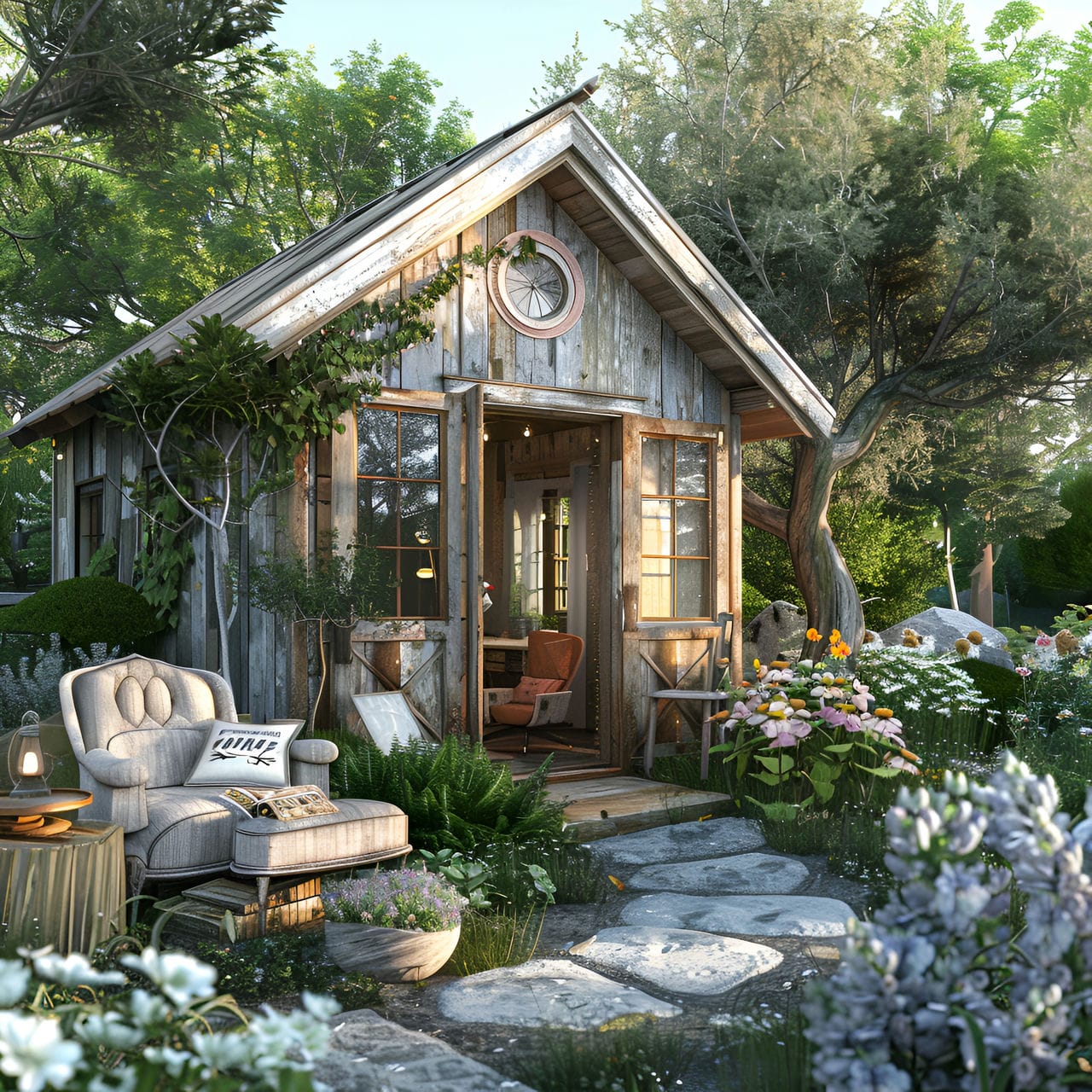
How much does it typically cost to renovate a she shed?
The typical cost to renovate an average-size shed ranges from $2,000 to $4,000 (€1,850 to €3,700, £1,600 to £3,400). Renovating tiny she sheds of 100 square feet (9.3 square meters). This includes a fresh coat of paint, new bare flooring, lighting fixtures, cabinetry, and windows to update the small space. Installation labor costs account for over half of the budget here. For mid-size she sheds renovation expenses for an average size of 150 square feet (13.9 square meters) to 250 square feet (23.2 square meters) would cost $5,000 to $9,000 (€4,650 to €8,350, £4,000 to £7,200). The additional footprint leads to pricier materials costs, including siding and roof repairs, insulation, higher-end flooring, extra storage cabinets, and countertops. This can also cover a mini-split heating unit. The largest she sheds can cost between $10,000 (€9,250, £8,000) to $30,000 (€27,800, £24,000) to renovate. The greater scope leads to major finishes like vaulted ceilings and upgraded electrical systems. Some include bathroom installation or contribute to converting into a luxury tiny guest home or backyard office.
What factors affect she shed renovation?
Listed below are the factors that affect the she shed renovation:
- Purpose and functionality: The intended purpose and functionality affect a she shed renovation. The design and modifications depend on whether the shed will be used as a hobby room, office, relaxation space, or for entertainment. This influences choices in layout, furniture, and storage solutions, ensuring the space is tailored to the specific activities it will accommodate.
- Space and size constraints: Space and size constraints are critical in a she shed renovation. Smaller sheds require creative space-saving solutions and multipurpose furniture for usability. The size dictates what can be achieved within the shed, impacting decisions on layout, furniture size, and the inclusion of various amenities.
- Budget considerations: Budget considerations are significant in a she shed renovation. Financial constraints determine the extent of the renovation, the quality of materials, and the types of furnishings and equipment that can be included.
- Weather and environmental conditions: Weather and environmental conditions influence a she shed renovation. The shed must be equipped to handle local weather patterns, requiring appropriate insulation, ventilation, and waterproofing.
- Material selection and durability: Materials and durability are crucial in a she shed renovation. The materials must withstand the external environment and suit the shed’s usage. This includes choices for exterior siding, roofing, flooring, and interior finishes.
- Aesthetic and style preferences: Aesthetic and style preferences shape the renovation of a she shed. The choice of colors, textures, and design elements should reflect the homeowner’s style and create a cohesive look.
- Compliance with building codes and regulations: Compliance with building codes and regulations is essential in a she shed renovation. Homeowners must ensure the renovation adheres to local building codes, especially if structural changes or utility installations are involved.
Is an architect required to renovate a she shed?
No, hiring an architect is not required to renovate a she shed, but it is highly advised to consider their services. Homeowners can often handle these tasks without needing an architect for minor shed renovations like repainting, updating decor, or making simple modifications. Architects can provide valuable insights when the shed renovation involves significant structural alterations, such as adding windows, expanding the space, or creating a unique and elaborate design. They can ensure that the refurbishment adheres to building codes, maximizes functionality, and brings a professional design sensibility to the project. The decision to hire an architect should align with the complexity and scope of the shed renovation and the homeowner’s specific goals.
How can an architect help you upgrade a she shed?
Listed below are the ways that an architect can help an owner upgrade a she shed:
- Custom design and layout: An architect can create a custom design and layout for a she shed upgrade tailored to the homeowner’s specific needs and preferences. They assess the available space and propose a layout that maximizes functionality, whether the shed is used as a hobby room, office, or relaxation retreat.
- Aesthetic enhancement: An architect contributes significantly to the aesthetic enhancement of a she shed. They can develop a design that reflects the homeowner’s style, creating a unique and inviting atmosphere.
- Lighting and ventilation design: An architect can optimize lighting and ventilation in a she shed upgrade. They plan window placements and skylights to maximize natural light, complemented by artificial lighting solutions for functionality and ambiance.
- Material selection and durability: An architect assists in selecting materials that ensure durability and sustainability in a she shed upgrade. They recommend materials suited for the local climate and intended use of the shed. This includes choices for exterior cladding, roofing, insulation, and interior finishes.
- Integration with the outdoor environment: An architect helps integrate the she shed with the outdoor environment. This includes designing elements like patios, decks, or landscaping that create a transition from the shed to the garden or backyard.
- Project management and coordination: An architect provides project management and coordination for the she shed upgrade. They oversee the project from conception to completion, ensuring all elements align with the design vision. This includes coordinating with contractors, managing budgets, and ensuring timely completion.
How much does it cost to hire an architect to renovate a she shed?
Hiring an architect to renovate a she shed costs between $1,500 (€1,400, £1,200) to $3,500 (€3,250, £2,800). For a small 100-square-foot (9.3 square meter) to 150-square-foot (13.9 square meter) shed layout, architect fees run $1,500 (€1,400, £1,200) to $2,500 (€2,300, £2,000). This includes 2-3 preliminary layouts, 2D floor plans, consultations on finishes, and permitting paperwork. It does typically cover full construction drawings or project management. For a midsize 200 square foot (18.6 square meters) to 300 square foot (27.9 square meters), she shed renovation into a studio or office space, expect costs from $2,500 (€2,300, £2,000) to $3,500 (€3,250, £2,800). The increased scope includes details like integrated storage, lighting plans, countertop layouts, and space planning advice—complete architectural services with extensive information, project management, and oversight costs.
Is it worth it to hire an architect to upgrade a she shed?
Yes, hiring an architect to upgrade a she shed can be a valuable investment. Architects bring a wealth of expertise in design, space optimization, and structural considerations that can significantly enhance the outcome of the upgrade. They can ensure that the space is pleasing but also functional and efficient, making the most of the available area. Architects can handle complex projects involving structural changes, such as adding windows, expanding the shed, or integrating utilities like electricity and plumbing. Their knowledge of building codes and regulations ensures that the upgrades comply with legal requirements, providing peace of mind.
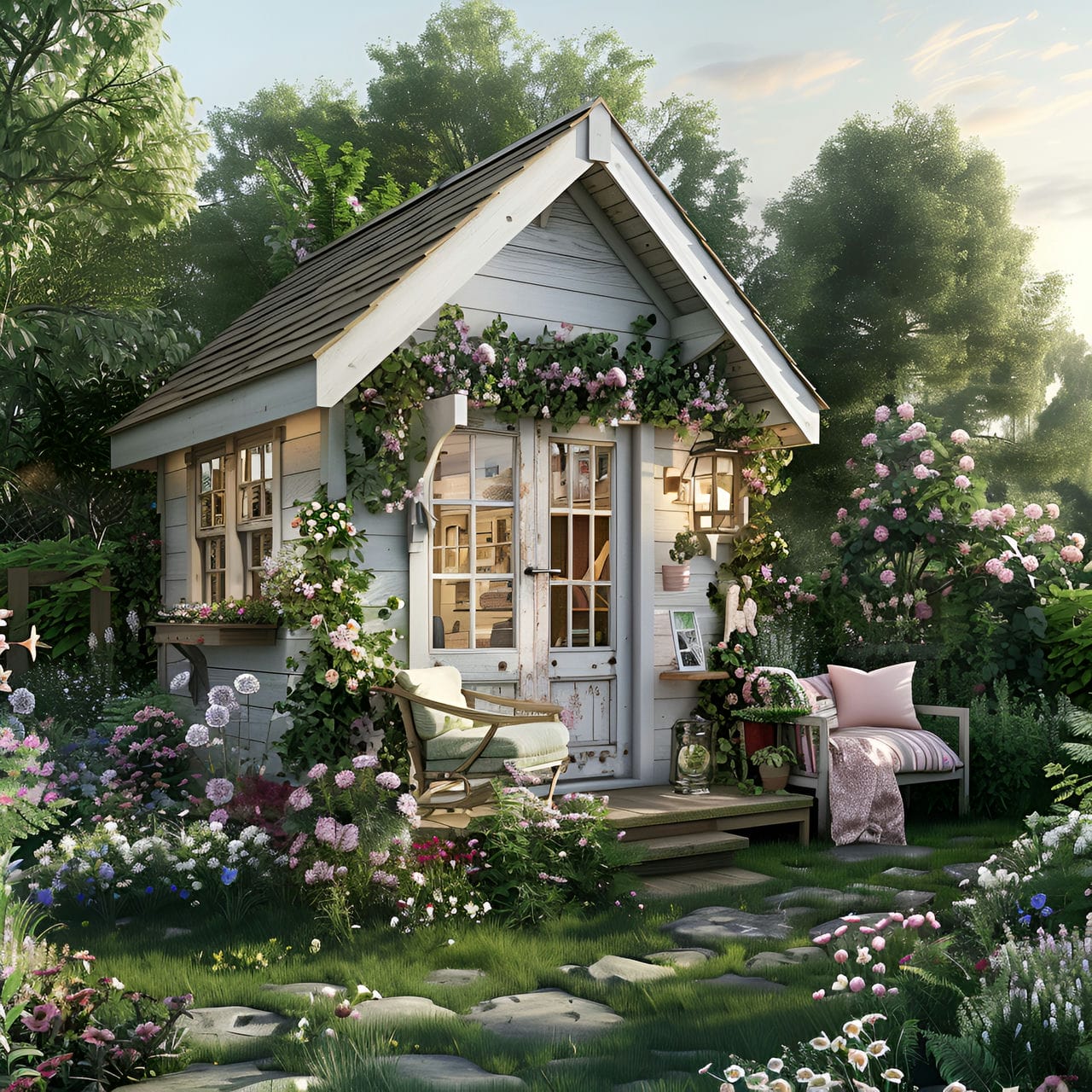
How long is needed to redecorate she shed?
To redecorate the she shed, a timeframe of 1 to 8 weeks is needed. Firstly, the scope and scale of the redecoration project play a significant role. The process can be completed relatively quickly for minor updates, such as repainting, changing decor, or updating furnishings, within 1 to 2 weeks. Secondly, if the redecoration involves more moderate changes, like installing new flooring, custom-built furniture, or adding new shelving or storage, the timeline may extend to 2 to 4 weeks. This accounts for the additional time needed for tasks like installation and potential delays in receiving custom-made items. Lastly, for comprehensive shed transformations that include significant structural changes, extensive custom designs, or the addition of utilities like electricity and plumbing, the process can take 4 to 8 weeks or even longer. Projects demand careful planning, coordination with professionals, and potential unforeseen challenges that could extend the timeline.
What are the struggles of the homeowner to redecorate a she shed?
Listed below are the struggles of the homeowner to redecorate a she shed:
- Defining the purpose and functionality: Homeowners often need help in redecorating and determining a she shed’s purpose and functionality. Deciding whether it should serve as a hobby space, relaxation area, home office, or a combination of uses can be challenging.
- Space optimization: Space optimization is a significant challenge in a shed. Homeowners must efficiently use the limited space, often requiring multifunctional furniture and creative storage solutions. Balancing the desire for a spacious feel with the need for practical amenities and storage can be difficult.
- Budget constraints: Managing budget constraints is a common struggle during she shed redecoration. Homeowners must allocate funds for furniture, decorations, and potential structural changes, often leading to tough choices between desired features and cost-effective alternatives.
- Style and aesthetic coherence: Achieving a cohesive style and aesthetic in a shed can be daunting in redecoration. Homeowners must select a decor theme and color palette that reflects their taste and creates a harmonious and inviting environment. This involves a careful selection of furniture, textiles, and decorative elements.
- Weatherproofing and insulation: Proper weatherproofing and insulation are crucial for a she shed redecoration, mainly if used year-round. Homeowners must address challenges like maintaining a comfortable temperature, preventing moisture buildup, and protecting the interior from the elements.
- Access to utilities and connectivity: Providing access to utilities and connectivity is often a struggle in she shed redecoration. Running electricity, internet, or plumbing to an outdoor structure can be complex and costly. Homeowners must find practical solutions to equip the shed with necessary utilities while adhering to safety standards.
- Obtaining permits and adhering to regulations: Navigating the process of obtaining permits and adhering to local building regulations can be a significant challenge in she shed redecoration. Homeowners must ensure that any structural changes, electrical work, or effective modifications comply with local codes, which can be complicated and time-consuming.


